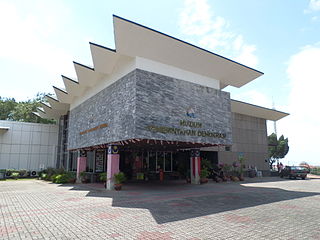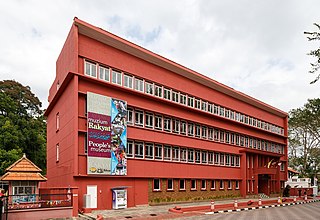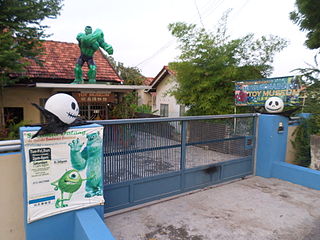
St. Paul's Hill (Malay : Bukit St. Paul) is a hill in Malacca City, Malacca, Malaysia. It was originally known as Malacca Hill (Malay : Bukit Melaka) [1] during the Sultanate period and Mary's Hill during the Portuguese period. [2] [3]

St. Paul's Hill (Malay : Bukit St. Paul) is a hill in Malacca City, Malacca, Malaysia. It was originally known as Malacca Hill (Malay : Bukit Melaka) [1] during the Sultanate period and Mary's Hill during the Portuguese period. [2] [3]
| Image | Name | Description |
|---|---|---|
 | Democratic Government Museum (Malay : Muzium Pemerintahan Demokrasi) | A museum about the development and practice of parliamentary democracy in Malaysia, it was formerly the Malacca State Legislative Assembly building, which was moved to Ayer Keroh as its present location since February 2000. [4] [5] [6] |
 | The Dutch Graveyard (Malay : Kubur Belanda) | A graveyard first used in the last quarter of 17th century and used in two stages, in which the first one was in 1670–1682 by the Dutch themselves and the second one in 1818–1838 by the British. A total of 5 Dutch officers and 33 British officers and their spouses were buried there. [7] |
 | Governor's Museum (Malay : Muzium Yang di-Pertua Negeri) | A museum which exhibits the personal belongings of various governors of Malacca since the independence of Malaya. Its building was formerly used as the official residence and office of the Dutch Governor of Malacca and also the official residence of the Yang di-Pertua Negeri of Malacca named Seri Melaka from independence until September 1996, when it was turned into a museum and officially opened to the public in 2002. [8] [9] |
 | Malacca Literature Museum (Malay : Muzium Sastera Melaka) | Officiated by Chief Minister Mohd Zin Abdul Ghani in 1984, it is a museum which displays Malaysian literary works from the Malacca Sultanate period to contemporary Malaysia, such as written history of Malacca, the writings of Munsyi Abdullah, local Malay folklore and the laws of the Malacca Sultanate. [10] [11] The museum's building was believed to be formerly an officer residence during the British colonial era, a criminal detention room during the Japanese occupation era and was the Malacca State Development Corporation headquarters from 1974 until 1984. [12] Graphical panels, exhibition boxes, audio visual and kiosk information are some of the techniques used to display the items in the museum. [13] A mural that depicts of evolution of literature composition in Malaysia from the use of stone tablets to computer and keyboard is displayed in front of the museum. [14] |
 | Church of St. Paul | A historic church building that was originally built in 1521 and dedicated to Virgin Mary, making it the oldest of its kind in Malaysia and Southeast Asia. [15] |

Ayer Keroh is a town situated in Melaka Tengah District, Malacca, Malaysia. It is the seat of the state government since 2006, being the home of the state secretariat building complex – Seri Negeri complex and one of a few towns which formed the Hang Tuah Jaya municipality.

Melaka Tengah District is one of the three administrative districts in Malacca, Malaysia. It borders Alor Gajah District to the north and Jasin District to the east. The capital of the state, Malacca City, is located in this district. This district is the major destination of tourists in Malacca as most historical spots are situated within it.

Malacca Sultanate Palace Museum is a museum located in Malacca City, Malacca, Malaysia. The building is a modern reconstruction of the palace of the Malacca Sultanate, based on the information and data obtained from the Malay Annals. It is made up of hardwood, 'belian' wood and wooden pegs and was constructed in 1984 and became a cultural museum which showcases the history of the region. The museum was officially opened on 17 July 1986 by Prime Minister Mahathir Mohamad.

Malacca, officially the Historic State of Malacca, is a state in Malaysia located in the southern region of the Malay Peninsula, facing the Strait of Malacca. The state is bordered by Negeri Sembilan to the north and west and Johor to the south. The exclave of Tanjung Tuan also borders Negeri Sembilan to the north. Its capital is Malacca City, which has been listed as a UNESCO World Heritage Site since 7 July 2008. Malacca City is 148 kilometres southeast of Malaysia's capital city Kuala Lumpur, 235 kilometres northwest of Johor's largest city Johor Bahru and 95 km northwest of Johor's second largest city, Batu Pahat.

Malacca Stamp Museum is a postal museum in Malacca City, Malacca, Malaysia. It is housed in a building that was constructed using local materials and has the shape and characteristics of western architecture.

The Education Museum is a museum in Malacca City, Malacca, Malaysia, which exhibits the historical development of the state's education system from the Malacca Sultanate, British Malaya, Japanese occupation and the present time.

The Malaysia Youth Museum is a museum in Malacca City, Malacca, Malaysia, which dedicated to the youth of Malaysia and their contribution to the economic and social wellbeing at regional, national, and international levels.

The Chitty Museum is a museum about the minority Chitty community, which is located within the Chitty Village area in Malacca City, Malacca, Malaysia. It is housed in a traditional Chitty house which has been renovated by PERZIM.

The Democratic Government Museum is a museum about the development and practice of parliamentary democracy, which is located at St. Paul's Hill in Malacca City, Malacca, Malaysia. The museum was formerly the Malacca State Legislative Assembly building, which had moved to Ayer Keroh as its present location since February 2000, in which its foundation stone was laid on 13 August 1961.

People's Museum is a museum in Malacca City, Malacca, Malaysia, which records and preserves the achievements of Malacca in the development sector and officially opened on 15 April 1992 by then Prime Minister Mahathir Mohamad. It is located at the ground floor of the former Historical City of Malacca Municipal Council building, originally constructed in the 1960s and believed to be built on top of the ruins of Dutch building, which also houses the Beauty Museum and Kite Museum at the upper floors.

Malacca Literature Museum is a museum about Malaysian literary works in Malacca City, Malacca, Malaysia, which resembles the structural design of a residence and was officiated by Chief Minister Mohd Zin Abdul Ghani in 1984.

Maritime Museum is a museum about maritime activities in Malacca City, Malacca, Malaysia. It was officially opened to the public by Prime Minister Mahathir Mohamad on 13 June 1994, began with phase one. The phase two of the museum is housed in the old Guthrie building and was opened by State Committee for Tourism, Culture and Environment Chairman Poh Ah Tiam on 23 May 1998.

Beauty Museum or Museum of Enduring Beauty is a museum about beauty standards and concepts in Malacca City, Malacca, Malaysia, which was opened in 1996. It occupies the top floor of the former Historical City Municipal Council building, originally constructed in the 1960s and believed to be built on top of the ruins of Dutch building, which also houses the People's Museum and Kite Museum at the ground and the upper floor respectively.

Kite Museum is a museum about kites in Malacca City, Malacca, Malaysia, which was officially opened in September 1995 by Chief Minister Mohd Zin Abdul Ghani in conjunction with the Regional Malay Customs seminar. It occupies the upper floor of the former Historical City Municipal Council building, originally constructed in the 1960s and believed to be built on top of the ruins of Dutch building, which also houses the People's Museum and Beauty Museum at the ground floor and top floor respectively. The museum displays various aspects of kites, such as communication, use as weapons, sport, leisure activities, how different countries make kites, different materials to make kites, role of kites in the life of people etc. It also displays the Wau Gallery, Traditional Games, Top Spinning Gallery and Datuk Wira Haji Md Borhan bin Yaman Gallery. It opens everyday from 9.00 a.m. to 5.00 p.m.

The Governor's Museum is a museum atop St. Paul's Hill in Malacca City, Malacca, Malaysia, which exhibits the personal belongings of various governors of Malacca since the independence of Malaya. The museum's building was formerly used as the official residence and office of the Dutch governor of Malacca. It was then used as the official residence of the Yang di-Pertua Negeri of Malacca until September 1996, before being turned into a museum, which was officially opened to the public in 2002.

The Malay and Islamic World Museum is a museum about Malay and Islamic cultures in Malacca City, Malacca, Malaysia. It is housed in the Bastion House building which was built in 1910 and occupied by the British rubber company Dunlop until 1986. The building has the English architectural elements, the rectangular shape design with deep slanted roofs. The museum displays the information about the spread of Islam in the world, important and historical Malay and Muslim figures, important Islamic buildings, artifacts, traditional dress etc.

Melaka Toy Museum is a private museum about toy collections in Bukit Baru, Malacca, Malaysia. It is the second toy museum opened in Malaysia after Penang Toy Museum.

The Aborigines Museum is a museum in Ayer Keroh, Malacca, Malaysia, which showcases the native people relics found in the country. It was originally located inside Ayer Keroh Recreational Forest, but later relocated to its present area along Lebuh Ayer Keroh in December 1996 and went under the management of Malacca Museum Corporation. The museum was reopened on 3 February 1997.